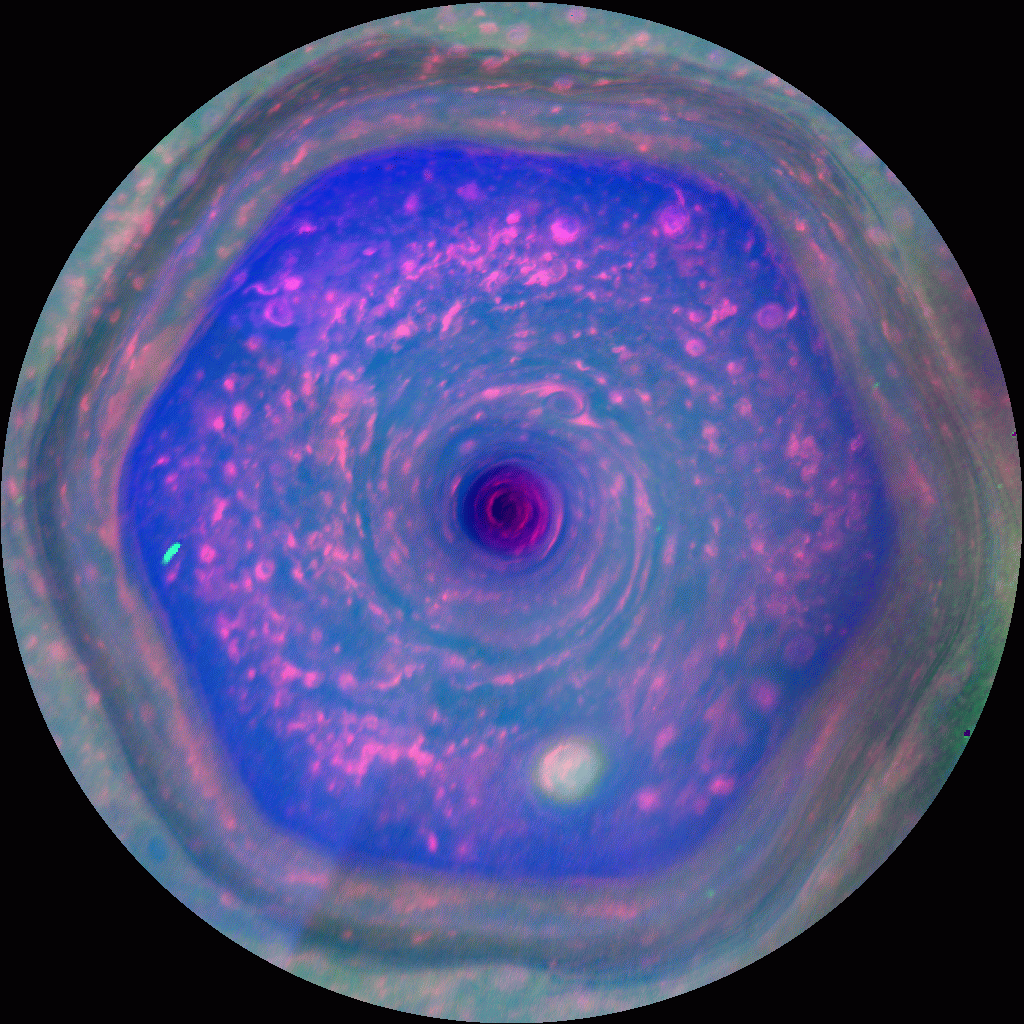Scientists Focus On Surprising Feature Emerging At Saturn’s Northern Pole
A new study based on observations by Cassini’s Composite Infrared Spectrometer (CIRS) has discovered a surprising feature emerging at Saturn’s northern pole as it nears summertime: a warming, high-altitude vortex with a hexagonal shape, akin to the famous hexagon seen deeper down in Saturn’s clouds.
To make this observation, scientists have used Cassini data spanning 2013 to 2017 to discover a similar vortex located in Saturn’s northern polar stratosphere.

Saturn’s northern polar hexagon in motion. Credit: NASA/JPL-Caltech/SSI/Hampton University
Researchers say it could be a towering structure spanning hundreds of kilometers in height.
“The edges of this newly-found vortex appear to be hexagonal, precisely matching a famous and bizarre hexagonal cloud pattern we see deeper down in Saturn’s atmosphere,” says Leigh Fletcher of the University of Leicester, UK, lead author of the new study.
“While we did expect to see a vortex of some kind at Saturn’s north pole as it grew warmer, its shape is really surprising. Either a hexagon has spawned spontaneously and identically at two different altitudes, one lower in the clouds and one high in the stratosphere, or the hexagon is in fact a towering structure spanning a vertical range of several hundred kilometers.”
Saturn’s cloud levels host the majority of the planet’s weather, including the pre-existing north polar hexagon. This feature was discovered by NASA’s Voyager spacecraft in the 1980s and has been studied for decades; it is a long-lasting wave potentially tied to Saturn’s rotation, a type of phenomenon also seen on Earth in structures such as the Polar Jet Stream.
The presence of a hexagon way up in Saturn’s northern stratosphere, hundreds of kilometers above the clouds, suggests that there is much more to learn about the dynamics at play in the gas giant’s atmosphere.
A single, towering hexagonal structure that stretches up through the atmosphere would be unlikely given that wind conditions change considerably with altitude.
“One way that wave ‘information’ can leak upwards is via a process called evanescence, where the strength of a wave decays with height but is just about strong enough to still persist up into the stratosphere,” explains Fletcher. “We simply need to know more. It’s quite frustrating that we only discovered this stratospheric hexagon right at the end of Cassini’s lifespan.”
Understanding how and why Saturn’s north polar vortex has assumed a hexagonal shape will shed light on how phenomena deeper down in an atmosphere can influence the environment high up above.
Saturn’s north polar region is expected to continue developing in coming years; the northern hemisphere passed summer solstice in May 2017, and is on track for its autumn equinox in 2024.
Read more in original story



 Creators of mankind
Creators of mankind Description of “Tall white aliens”
Description of “Tall white aliens” Where they came from?
Where they came from? About hostile civilizations
About hostile civilizations The war for the Earth
The war for the Earth “Tall white aliens” about eternal life
“Tall white aliens” about eternal life Video: “Nordic aliens”
Video: “Nordic aliens” Aliens
Aliens Alien encounters
Alien encounters The aliens base
The aliens base UFO
UFO Technology UFO
Technology UFO Underground civilization
Underground civilization Ancient alien artifacts
Ancient alien artifacts Military and UFO
Military and UFO Mysteries and hypotheses
Mysteries and hypotheses Scientific facts
Scientific facts


















